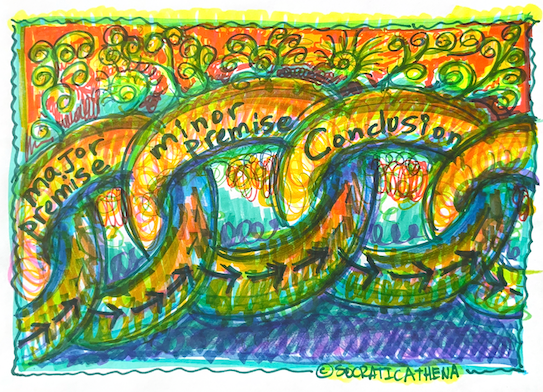Logical Argument 101
A timeless reasoning pattern for exposing flawed judgments. For when you need to defend yourself, like a logical lawyer.


"How fortunate for leaders that men do not think." – Adolf Hitler
Logical Arguments: "Syllogism"
A syllogism is a structured way to prove that a statement is valid (or flawed) using just three connected statements. This knowledge is a life saver when you need a "lawyer on the fly".
The pattern works like a proof, in equation form: IF you accept both premises as true, then the conclusion that follows, logically, is the one that's logically valid. This may seem simple or obvious to some, overly complicated to others. However, once you start recognizing this basic pattern in every conversation, you will have developed a very powerful self-defense instinct that you can use on the fly--one that's especially useful when your emotions need to take a backseat to reason.
Ingredients:
A Judgment: A statement about a specific thing, e.g., Socrates is mortal
A major premise: A statement (given or implied) that sets a broad rule for the judgment, e.g., All humans are mortal
A minor premise: A statement that places a specific person, place, or thing under a rule, e.g., Socrates is human
Instructions:
Suppose someone says this: Socrates is mortal because all humans are mortal
First, organize the given facts:
...The specific thing: Socrates
...The judgment: Socrates is mortal
...The premise/basis/because: ...because all humans are mortal
Second, reconstruct the simple yet full logical* argument:
Major Premise: All humans are mortal
Minor Premise: Socrates is a human
Conclusion: Therefore, Socrates is mortal
*The more logical argument patterns you know, the better; see Syllogism Patterns.
Third, compare the logical conclusion to the original judgment.
What is the original judgment, as stated? Socrates is mortal
What is the logical conclusion? Socrates is mortal
Does the original judgment match the logical conclusion? Yes
If the original doesn’t match the logical judgment, adjust the premises.
If the original does match the logical judgment, use the syllogism structure as proof.
Uses:
Defending a sound judgment
Exposing flaws in judgments, standards, and reasoning
Strengthening claims in debates and discussions
Explaining ideas with logical clarity
Self-Preservation:
Mental Clarity: Using proof like an equation prevents confusion and misinterpretation
Intellectual Integrity: A structured approach keeps reasoning precise and honest
Argument Strength: Well-formed proofs make claims harder to dispute
Error Detection: Recognizing logical structures helps catch flawed reasoning
Decision Confidence: A solid proof provides a strong foundation for making and defending choices
Plants and Logic
Recipes for Self-Preservation
Contact
© 2025. All rights reserved.